初中英语语法:句型结构中的“否定转移” 2
否定转移的用法

否定转移的用法公司内部编号:(GOOD-TMMT-MMUT-UUPTY-UUYY-DTTI-否定转移的用法1) 将think, believe, suppose, expect, fancy, imagine等动词后面宾语从句的否定词转移到主句中,即主句的谓语动词用否定式,而从句的谓语动词用肯定式。
I don”t think I know you. 我想我并不认识你。
I don” t believe he will come. 我相信他不回来。
注意:若谓语动词为hope,宾语从句中的否定词不能转移。
I hope you weren”t ill. 我想你没有生病吧。
2) 将seem, appear 等后的从句的否定转移到前面。
It doesn”t seem that they know where to go.看来他们不知道往哪去。
It doesn”t appear that we”ll have a sunny day tomorrow.看来我们明天不会碰上好天气。
3) 有时将动名词,介词短语或整个从句的否定转变为对谓语动词的否定。
I don”t remember having ever seen such a man.我记得从未见过这样一个人。
(not否定动名词短语 having…)It”s not a place where anyone would expect to see strange characters on the street.在这里,人们不会想到在街上会碰上陌生的人。
(anyone 作主语,从句中的谓语动词不能用否定形式。
)否定转移用法总结kenny128 (2006-03-11 12:52)有感于课文中一句话的理解)山东高唐一中刘长友外研版的新课标英语课本第二册Module 1 “Zhou Kai(2)p2中有这样一句话:I think I don’t get these things because I take a lot of exercise and am very fit.不少有学有基础的学生,其中包括一些老师,对这一个句子中,该不该用否定转移的句子,展开了激烈讨论。
否定转移

Yes, they do. 不,他们工作努力。/No, they don’t. 对, 他们工作不努力
肯定反意疑问句的回答
当陈述部分为否定式,反意疑问句为肯定式时,其回答往往与汉语不一致,需特别引起注意:
She must have read the novel last week,didn't she?
她上星期一定读了这本小说,是吗?
You must have told her about it,haven't you?
你一定把这事告诉她了,是吗?
回答
反意疑问句的回答用yes, no, 但是,回答意思相反,当陈述部分是否定形式时,回答要按事实。如:
在这种句式中,not从宾语从句的谓语动词的前面转移到了主句谓语动词think,believe,suppose等的前面。例如:
I&ink I know you.对不起,我想我并不认识你。
I don't believe he'll come.我想他是不会来的。
Let me help you,may I?
Turn on the radio, will you?
There be句型
There be 句型中,反义疑问部分必须为 be 动词 + there
There are some apples in the basket, aren't there?
3.not…+动词不定式或介词短语
在这类结构中,我们实际上是将否定后面不定式的not转移到了谓语动词上。如:
Jack doens't seem to like you.(= Jack seems not to like you.)杰克看来不喜欢你。
英语中的否定转移
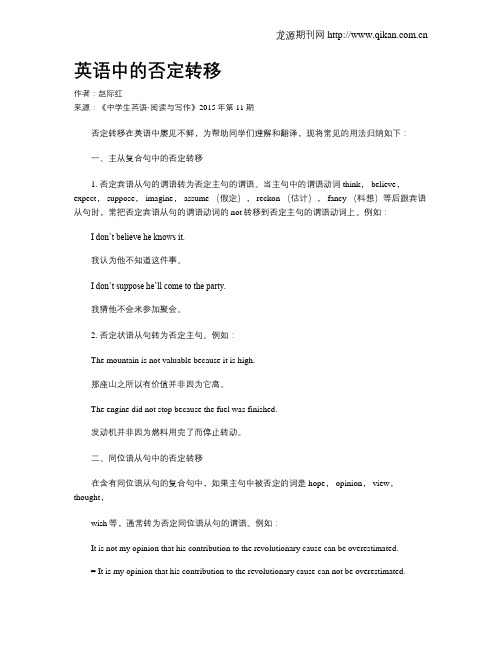
英语中的否定转移作者:赵际红来源:《中学生英语·阅读与写作》2015年第11期否定转移在英语中屡见不鲜,为帮助同学们理解和翻译,现将常见的用法归纳如下:一、主从复合句中的否定转移1. 否定宾语从句的谓语转为否定主句的谓语。
当主句中的谓语动词think, believe,expect, suppose, imagine, assume (假定), reckon (估计), fancy (料想)等后跟宾语从句时,常把否定宾语从句的谓语动词的not转移到否定主句的谓语动词上。
例如:I don’t believe he knows it.我认为他不知道这件事。
I don’t suppose he’ll come to the party.我猜他不会来参加聚会。
2. 否定状语从句转为否定主句。
例如:The mountain is not valuable because it is high.那座山之所以有价值并非因为它高。
The engine did not stop because the fuel was finished.发动机并非因为燃料用完了而停止转动。
二、同位语从句中的否定转移在含有同位语从句的复合句中,如果主句中被否定的词是hope, opinion, view,thought,wish等,通常转为否定同位语从句的谓语。
例如:It is not my opinion that his contribution to the revolutionary cause can be overestimated.= It is my opinion that his contribution to the revolutionary cause can not be overestimated.我的看法是他对革命事业的贡献怎么估计也不过分。
(cannot... over do与cannot... too + adj./ adv.都是形式否定而意义肯定的固定句式,意为:怎么……也不过分,越……越……)It is not his thought that you should buy that car at all.= It is his thought that you should not buy that car at all.他认为你完全没必要买那辆车。
初一英语否定形式的知识点总结
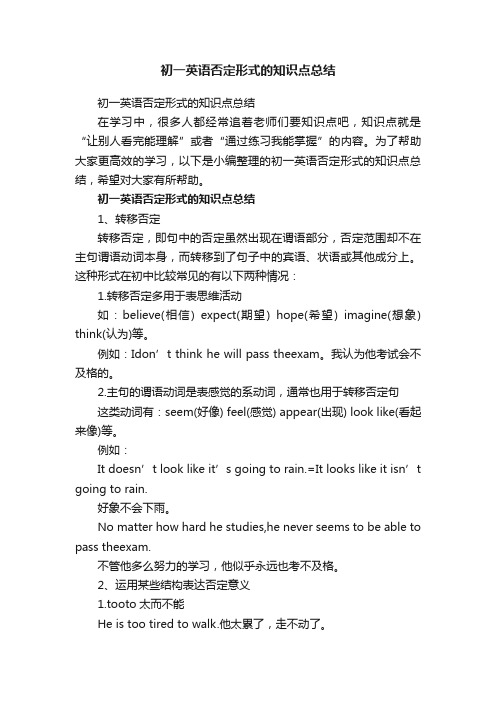
初一英语否定形式的知识点总结初一英语否定形式的知识点总结在学习中,很多人都经常追着老师们要知识点吧,知识点就是“让别人看完能理解”或者“通过练习我能掌握”的内容。
为了帮助大家更高效的学习,以下是小编整理的初一英语否定形式的知识点总结,希望对大家有所帮助。
初一英语否定形式的知识点总结1、转移否定转移否定,即句中的否定虽然出现在谓语部分,否定范围却不在主句谓语动词本身,而转移到了句子中的宾语、状语或其他成分上。
这种形式在初中比较常见的有以下两种情况:1.转移否定多用于表思维活动如:believe(相信) expect(期望) hope(希望) imagine(想象) think(认为)等。
例如:Idon’t think he will pass theexam。
我认为他考试会不及格的。
2.主句的谓语动词是表感觉的系动词,通常也用于转移否定句这类动词有:seem(好像) feel(感觉) appear(出现) look like(看起来像)等。
例如:It doesn’t look like it’s going to rain.=It looks like it isn’t going to rain.好象不会下雨。
No matter how hard he studies,he never seems to be able to pass theexam.不管他多么努力的学习,他似乎永远也考不及格。
2、运用某些结构表达否定意义1.tooto太而不能He is too tired to walk.他太累了,走不动了。
2.more A than B(与其B不如A)或more than+含有can的从句例如:1、They oung man is more brave than wise.这年轻人有勇无谋。
2、The grat it ude for your help is more than I can express.对于你给我的感激之情我无法言表。
初中英语语法句型结构中的“否定转移”
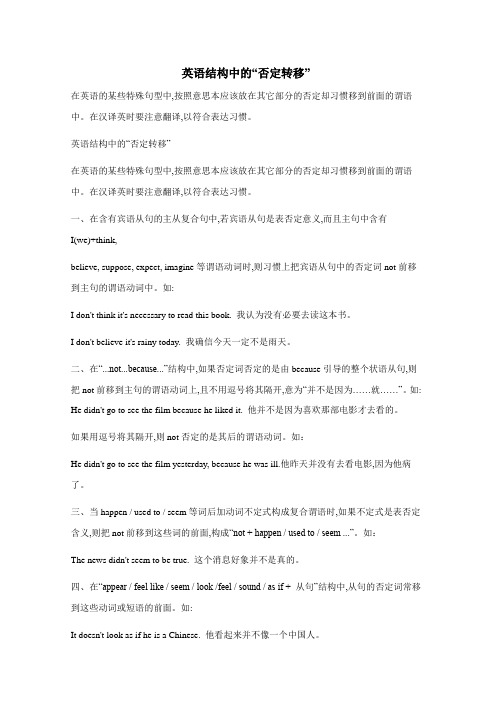
英语结构中的“否定转移”在英语的某些特殊句型中,按照意思本应该放在其它部分的否定却习惯移到前面的谓语中。
在汉译英时要注意翻译,以符合表达习惯。
英语结构中的“否定转移”在英语的某些特殊句型中,按照意思本应该放在其它部分的否定却习惯移到前面的谓语中。
在汉译英时要注意翻译,以符合表达习惯。
一、在含有宾语从句的主从复合句中,若宾语从句是表否定意义,而且主句中含有I(we)+think,believe, suppose, expect, imagine等谓语动词时,则习惯上把宾语从句中的否定词not前移到主句的谓语动词中。
如:I don't think it's necessary to read this book. 我认为没有必要去读这本书。
I don't believe it's rainy today. 我确信今天一定不是雨天。
二、在“...not...because...”结构中,如果否定词否定的是由because引导的整个状语从句,则把not前移到主句的谓语动词上,且不用逗号将其隔开,意为“并不是因为……就……”。
如: He didn't go to see the film because he liked it. 他并不是因为喜欢那部电影才去看的。
如果用逗号将其隔开,则not否定的是其后的谓语动词。
如:He didn't go to see the film yesterday, because he was ill.他昨天并没有去看电影,因为他病了。
三、当happen / used to / seem等词后加动词不定式构成复合谓语时,如果不定式是表否定含义,则把not前移到这些词的前面,构成“not + happen / used to / seem ...”。
如:The news didn't seem to be true. 这个消息好象并不是真的。
英语句子的否定转移用法
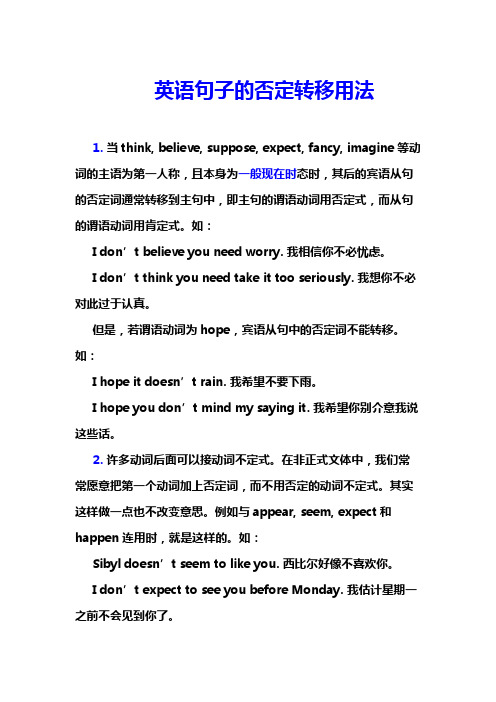
英语句子的否定转移用法1.当think, believe, suppose, expect, fancy, imagine等动词的主语为第一人称,且本身为一般现在时态时,其后的宾语从句的否定词通常转移到主句中,即主句的谓语动词用否定式,而从句的谓语动词用肯定式。
如:I don’t believe you need worry.我相信你不必忧虑。
I don’t think you need take it too seriously. 我想你不必对此过于认真。
但是,若谓语动词为hope,宾语从句中的否定词不能转移。
如:I hope it doesn’t rain.我希望不要下雨。
I hope you don’t mind my saying it.我希望你别介意我说这些话。
2.许多动词后面可以接动词不定式。
在非正式文体中,我们常常愿意把第一个动词加上否定词,而不用否定的动词不定式。
其实这样做一点也不改变意思。
例如与appear, seem, expect和happen连用时,就是这样的。
如:Sibyl doesn’t seem to like you.西比尔好像不喜欢你。
I don’t expect to see you before Monday.我估计星期一之前不会见到你了。
It does not seem that the man understand what I am saying. 那男人似乎不了解我在说什么。
与“intend / want+动词不定式”连用时,我们几乎总是将not / never与第一个动词放在一起。
如:I don’t want to fail this exam.这次考试我不想考不及格。
After I’ve finished this contract I never intend to teach again. 这个合同期满后,我决不想再教书了。
请注意can’t seem to…这一结构。
英语中的否定转移现象分析-最新文档
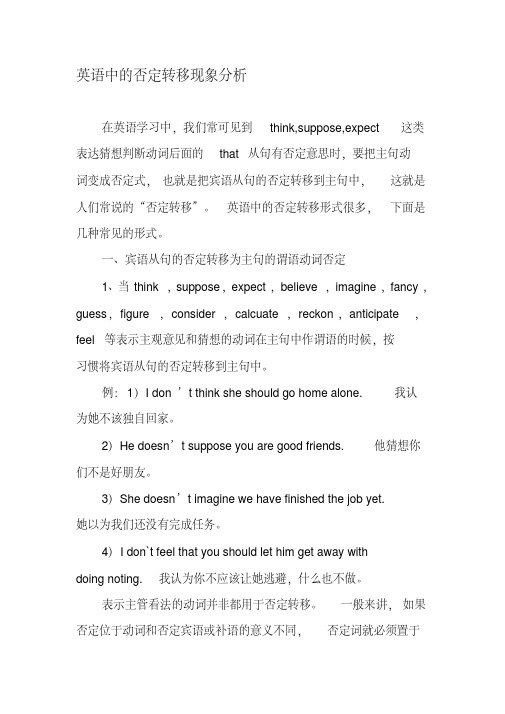
英语中的否定转移现象分析在英语学习中,我们常可见到think,suppose,expect这类表达猜想判断动词后面的that从句有否定意思时,要把主句动词变成否定式,也就是把宾语从句的否定转移到主句中,这就是人们常说的“否定转移”。
英语中的否定转移形式很多,下面是几种常见的形式。
一、宾语从句的否定转移为主句的谓语动词否定1、当think,suppose,expect,believe,imagine,fancy,guess,figure,consider,calcuate,reckon,anticipate,feel等表示主观意见和猜想的动词在主句中作谓语的时候,按习惯将宾语从句的否定转移到主句中。
例:1)I don’t think she should go home alone.我认为她不该独自回家。
2)He doesn’t suppose you are good friends.他猜想你们不是好朋友。
3)She doesn’t imagine we have finished the job yet.她以为我们还没有完成任务。
4)I don`t feel that you should let him get away withdoing noting.我认为你不应该让她逃避,什么也不做。
表示主管看法的动词并非都用于否定转移。
一般来讲,如果否定位于动词和否定宾语或补语的意义不同,否定词就必须置于要否定的部分之前,这类动词主要有:mean,know,hear,hope,fear,assume,surmise,presume,etc.请比较下列几组例句。
A、I don’t mean you did it right.我并不是说你做的对。
I mean you didn’t do it right.我是说你做的不对。
B、He heard that I would go abroad.他听说我不出国了。
否定转移

否定转移否定转移是指否定形式在主句,而否定的信息焦点却在从句或否定形式在谓语动词,而否定的信息焦点却在状语或表语。
一、动词的否定转移1. 形式上否定主句的谓语,实际上是否定从句的谓语。
当动词think, believe, suppose, imagine, expect, feel等的主语是第一人称、谓语动词为没有任何副词修饰的一般现在时,它们的否定式一般是对宾语从句的否定。
表示说话者提出一种委婉的看法或主张。
如:I don’t think that he will help us. (我认为他不会帮助我们。
)﹡注意hope不可用于否定转移。
2. 形式上否定谓语动词,实际上否定复合宾语。
当动词think, believe, suppose, imagine, expect, feel等的主语是第一人称、谓语动词为没有任何副词修饰的一般现在时,它们前面的否定式一般是对复合宾语的否定。
表示说话者所提出的一种委婉的看法或主张。
如:I think math difficult. —I don’t think math difficult. (我认为数学不难。
)【温馨提示】在以下情况下,一般不发生否定转移:(1) 这些动词跟另一个动词一起做并列谓语时,否定一般不转移。
如:I believe and hope he won’t do that. (我相信并且也希望他将不会那样做。
)(2) 用于疑问句时,否定一般不转移。
如:Do you think it is not going to rain? (你认为天不会下雨吗?)(3) 用作插入语时,否定一般不转移。
如:Li Lei, I think, won’t be angry with you. (我想李磊不会生你的气。
)(4) 当主句中含有状语或含有情态助动词时,否定一般不转移。
如:They still didn’t believe that the flood would come. (他们仍然不相信洪水会来临。
- 1、下载文档前请自行甄别文档内容的完整性,平台不提供额外的编辑、内容补充、找答案等附加服务。
- 2、"仅部分预览"的文档,不可在线预览部分如存在完整性等问题,可反馈申请退款(可完整预览的文档不适用该条件!)。
- 3、如文档侵犯您的权益,请联系客服反馈,我们会尽快为您处理(人工客服工作时间:9:00-18:30)。
英语结构中的“否定转移”
在英语的某些特殊句型中,按照意思本应该放在其它部分的否定却习惯移到前面的谓语中。
在汉译英时要注意翻译,以符合表达习惯。
英语结构中的“否定转移”
在英语的某些特殊句型中,按照意思本应该放在其它部分的否定却习惯移到前面的谓语中。
在汉译英时要注意翻译,以符合表达习惯。
一、在含有宾语从句的主从复合句中,若宾语从句是表否定意义,而且主句中含有
I(we)+think,
believe, suppose, expect, imagine等谓语动词时,则习惯上把宾语从句中的否定词not前移到主句的谓语动词中。
如:
I don't think it's necessary to read this book. 我认为没有必要去读这本书。
I don't believe it's rainy today. 我确信今天一定不是雨天。
二、在“...not...because...”结构中,如果否定词否定的是由because引导的整个状语从句,则把not前移到主句的谓语动词上,且不用逗号将其隔开,意为“并不是因为……就……”。
如: He didn't go to see the film because he liked it. 他并不是因为喜欢那部电影才去看的。
如果用逗号将其隔开,则not否定的是其后的谓语动词。
如:
He didn't go to see the film yesterday, because he was ill.他昨天并没有去看电影,因为他病了。
三、当happen / used to / seem等词后加动词不定式构成复合谓语时,如果不定式是表否定含义,则把not前移到这些词的前面,构成“not + happen / used to / seem ...”。
如:
The news didn't seem to be true. 这个消息好象并不是真的。
四、在“appear / feel like / seem / look /feel / sound / as if + 从句”结构中,从句的否定词常移到这些动词或短语的前面。
如:
It doesn't look as if he is a Chinese. 他看起来并不像一个中国人。
It doesn't sound as if he knew what had happened. 听起来他好像不知道刚才所发生的事情。
五、当由until作为连词或介词所引导的时间状语从句或短语中含有否定词时,常转移到主句谓语动词中,构成“...not...until...”结构。
如:
He doesn't go to bed until eleven every night. 他每晚直到11点才睡觉。
六、在“It is / was likely / probably +
从句”中,如果从句中用了否定结构,则把否定词转移到主句的谓语动词中。
如:
It isn't likely that it will rain tomorrow. 看起来明天不会下雨。
It isn't probable that he will come here today. 他今天也许不会来这里了。
七、在一些部分否定中,也可将否定谓语动词的否定词转移到主语上。
如:
Not all the people knew the truth. (=All the people didn't know the truth.)
并不是所有的人都知道事情的真相。
八、在一些句子中,句子形式上是否定动词,而实际上是否定状语部分。
如:
Don't judge a man by his appearance. 不要以貌取人。
He doesn't go to school by bus but on foot.
他不是步行去上学,而是坐公共汽车。
